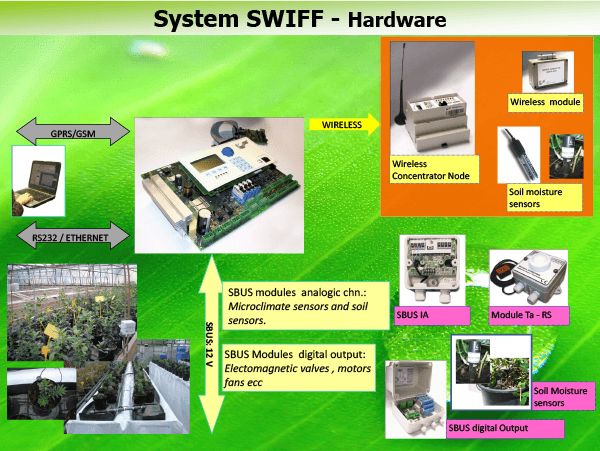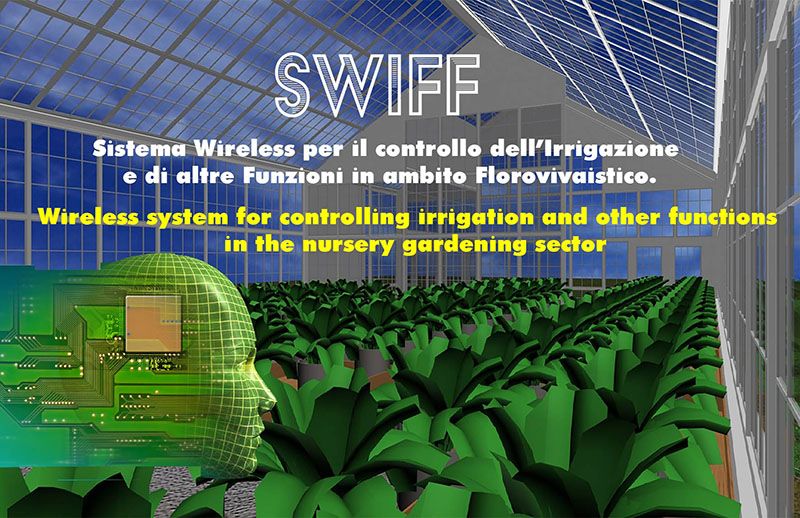Project SWIFF - “Sistema Wireless per il controllo dell’Irrigazione e di altre Funzioni in ambito Florovivaistico" funded by the Ministry for Agricultural, Food and Forestry Policies - M. D. 19173/7643 of 17.12.2008
In the managing of a protected productive environment, such as a greenhouse, the only introduction of automatic controls, even if electronic, does not able to ensure the observance of all required conditions for a profitable production and at the same time ecologically sustainable and safe from errors or malfunctioning. The project SWIFF intended to develop an innovative system for the control of the irrigation and other typical important functions of the productive activities of the nursery gardening sector.The mean aim of the research was to identify the modeling et electronic solutions (HW/SW) able to increase the systems representativeness and the reliability, assuring the maximum operative security and a gradual optimization in the use of the resources (water, fertilizer solution, thermoregulation, phytosanitary treatments, etc.) within the productive structure.
2009-2013
Bacci L., Battista P., Rapi B., Sabatini F.
In the last ten years the activity of our research group has been focused on the optimization of the water resources by means of the development of models and DSS (Decision Support System) for the management of the irrigation and fertigation both for open field crops and in nursery and greenhouse on horticultural and ornamental crops.
Nowadays there is a greater need to save water, for many reasons among which we can underline:
- The reduced water availability for the increasing competition with other sector of utilization (e.g. civil use, tourism, etc.)
- The progressive salinization of the aquifers
- The legislation that forces the nurserymen the use of technologies with a greater water efficiency.
An efficient irrigation management means to limit the drainage losses, that turns into a reduction of dispersion in the environment of fertilizer, pesticides and herbicides.
An integrated management of the controlled environment ensures a progressive optimization of the resources use (water, nutritive solution, thermoregulation, etc.) within the productive structure.
Project aims
Development of an automatic system by the use of new technologies and solutions wireless, for the:
- Optimal control of the potted ornamental plants and cut flowers species irrigation, cultivated in greenhouse on the bases of soil moisture measures and the mean meteorological parameters.
- Control of the greenhouse microclimate by the management of the existing environment conditioning systems: opening/closing doors, fan heaters, ventilation system, nebulization system, shadowing sheets, illumination, etc.
The system, with the irrigation and microclimate control, intends:
- To respect the plant water needs
- To reduce the use of water and nutrients
- To reduce the energy consumption
- To limit the environmental impact
The use of wireless technology allows to improve the monitoring and management of the main environmental and cultivation parameters inside the greenhouse, while reducing the problems related to the presence of connection cables and solving the problems of representativeness of the measuring points.
HARDWARE

Basic configuration: 8 Analog Inputs, 4 digital outputs (relay), 4 digital inputs (counter)
Expandability: RS-485, wireless modules (64), S-BUS modules (128)
Connection systems: RS-232, Ethernet, GSM / GPRS modem
Flexibility:
- System power supply (Vin = 24 Vdc; 18 Va)
- Sensor input range (0-5V; 0-20 mA)
- Power supply available (sensors): 5Vdc; 12 Vdc
Display + Keyboard for visualization and local configuration changes. Local archive of the last days m (eg. 58 values -> 12 days)
On the motherboard there is an S-BUS interface, allowing the connection of SBUS modules, to manage sensors and actuators through a single 4-wire bus that carries both the power supply (12 Vdc) and the information content.
SBUS "analog channels" module: it can be used with different types of sensors, since it accepts input signals in the range 0 ÷5 V, 0 ÷ 20 mA, while providing a power supply of 12 Vdc or 5 Vdc for any transducers. The SBUS "Digital Output" module: allows remote management of actuators for the control, for example, of solenoid valves of the irrigation system.
The modules operating on S-BUS are therefore slave units that respond to the requests of the master, communicating the status of the inputs or updating the digital outputs with the value received from the master.

On the motherboard there is an RS-485 interface that allows the connection of radio concentrators to manage wireless modules.
FIRMWARE
The system firmware allows:
- The sensors data acquisition managemen
- The irrigation management by means of the “soil-method”
- The irrigation control by means the integrated system using the soil-method together with the climate-method
- The microclimate control
- The data management: local and remote storage (GPRS/GSM)
- The alarms management by modem GPRS/GSM (alimentation faults, battery state, sensors faults, etc.)
The system integrate two methodologies to manage the water use: the soil method and the climate method.
Soil-Method |
Climate-Method |
|
Measurement of the soil water potential or of the volumetric water content Problem: risk of low representativeness of the measurement (correct identification of the sensor position in the pot, choice of the sample pot; need for more sensors) |
Method based on meteorological data: AET = ET0*Kc Main problem: Kc values generally unknown for the ornamental species |
The integrated system, based on the use at the same time of the “soil-method” and of the “climate-method”, allows to have positive effects on the water management, as:
- A better reliability of the automatic system
- A use of a lower number of sensors
- A better measurement representativeness
The graphic user interface (GUI)
The graphic user interface (GUI) of the software STR3000, allows the system remote control. The connection GPRS M2M enables to change the values of the setup variables in real time so to adapt the system running to different environmental and productive situations. By the GUI it is possible, furthermore, the graphical control of the micrometeorological parameters trend, allowing the direct monitoring of the operative environment.
